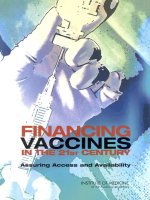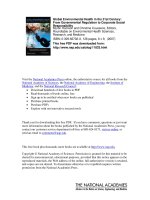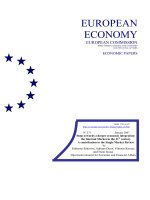marine biotechnology in the 21st century - nrc
Bạn đang xem bản rút gọn của tài liệu. Xem và tải ngay bản đầy đủ của tài liệu tại đây (33.85 MB, 131 trang )
Committee on Marine Biotechnology:
Biomedical Applications of Marine Natural Products
Ocean Studies Board
Board on Life Sciences
Division on Earth and Life Studies
National Research Council
NATIONAL ACADEMY PRESS
Washington, D.C.
PROBLEMS, PROMISE, AND PRODUCTS
MARINE
BIOTECHNOLOGY
IN THE TWENTY-FIRST CENTURY
NATIONAL ACADEMY PRESS • 2101 Constitution Ave., N.W. • Washington, DC 20418
NOTICE: The project that is the subject of this report was approved by the Governing
Board of the National Research Council, whose members are drawn from the councils
of the National Academy of Sciences, the National Academy of Engineering, and the
Institute of Medicine. The members of the committee responsible for the report were
chosen for their special competences and with regard for appropriate balance.
This report and the committee were supported by National Oceanographic and Atmo-
spheric Administration’s National Sea Grant College Program, the National Science
Foundation, The Whitaker Foundation, Minerals Management Service, Electric Power
Institute, and the National Academy of Sciences. The views expressed herein are those
of the authors and do not necessarily reflect the views of the sponsors.
Library of Congress Control Number: 2002105053
International Standard Book Number: 0-309-08342-7
Additional copies of this report are available from:
National Academy Press
2101 Constitution Avenue, N.W.
Box 285
Washington, DC 20055
800-624-6242
202-334-3313 (in the Washington Metropolitan area)
Copyright 2002 by the National Academy of Sciences. All rights reserved.
Printed in the United States of America
The National Academy of Sciences is a private, nonprofit, self-perpetuating society of
distinguished scholars engaged in scientific and engineering research, dedicated to the
furtherance of science and technology and to their use for the general welfare. Upon the
authority of the charter granted to it by the Congress in 1863, the Academy has a
mandate that requires it to advise the federal government on scientific and technical
matters. Dr. Bruce M. Alberts is president of the National Academy of Sciences.
The National Academy of Engineering was established in 1964, under the charter of
the National Academy of Sciences, as a parallel organization of outstanding engineers.
It is autonomous in its administration and in the selection of its members, sharing with
the National Academy of Sciences the responsibility for advising the federal govern-
ment. The National Academy of Engineering also sponsors engineering programs aimed
at meeting national needs, encourages education and research, and recognizes the supe-
rior achievements of engineers. Dr. Wm. A. Wulf is president of the National Academy
of Engineering.
The Institute of Medicine was established in 1970 by the National Academy of Sci-
ences to secure the services of eminent members of appropriate professions in the ex-
amination of policy matters pertaining to the health of the public. The Institute acts
under the responsibility given to the National Academy of Sciences by its congressional
charter to be an adviser to the federal government and, upon its own initiative, to
identify issues of medical care, research, and education. Dr. Kenneth I. Shine is presi-
dent of the Institute of Medicine.
The National Research Council was organized by the National Academy of Sciences
in 1916 to associate the broad community of science and technology with the Academy’s
purposes of furthering knowledge and advising the federal government. Functioning in
accordance with general policies determined by the Academy, the Council has become
the principal operating agency of both the National Academy of Sciences and the Na-
tional Academy of Engineering in providing services to the government, the public, and
the scientific and engineering communities. The Council is administered jointly by
both Academies and the Institute of Medicine. Dr. Bruce M. Alberts and Dr. Wm. A.
Wulf are chairman and vice chairman, respectively, of the National Research Council.
National Academy of Sciences
National Academy of Engineering
Institute of Medicine
National Research Council
COMMITTEE ON MARINE BIOTECHNOLOGY:
BIOMEDICAL APPLICATIONS OF
MARINE NATURAL PRODUCTS
NANCY TARGETT (Chair), University of Delaware, Lewes
ROBERT BAIER, State University of New York at Buffalo
WILLIAM GERWICK, Oregon State University, Corvallis
D. JAY GRIMES, University of Southern Mississippi, Ocean Springs
JOHN HEIDELBERG, The Institute for Genomic Research,
Rockville, Md.
SHIRLEY POMPONI, Harbor Branch Oceanographic Institution, Inc.,
Fort Pierce, Fla.
ROGER PRINCE, ExxonMobil Research & Engineering Company, N.J.
STAFF
JENNIFER MERRILL, Study Director, OSB
JENNIFER KUZMA, Senior Program Officer, BLS
DENISE GREENE, Senior Project Assistant
iv
v
In these proceedings the Ocean Studies Board and the Board on Life
Sciences ad hoc Committee on Marine Biotechnology summarize and inte-
grate information obtained from two workshops on Marine Biotechnology
(October 5-6, 1999, and November 5-6, 2001). We use that information
as a basis for recommending promising research areas in marine biotech-
nology. The 1999 workshop and its subsequent report emphasized envi-
ronmental applications for marine biotechnology and included the topics
of biomaterials, bioremediation, restoration, prediction and monitoring,
and economic and regulatory aspects. The 2001 workshop (whose pro-
ceedings are incorporated into this report) emphasized biomedical applica-
tions of marine biotechnology and included the topics of drug discovery
and development; genomic and proteomic applications for marine
bioproduct discovery; biomaterials and bioengineering; and public policy,
partnerships, and outreach. Considering marine biotechnology within this
broad context, the committee identifies promising research areas and high-
lights issues that are slowing the implementation of marine biotechnology
in the environmental and biomedical arenas. While aquaculture practices
are relevant to the production and sustainability of marine natural products
development, an in-depth examination of this large topic was beyond the
scope of the current project.
The Committee acknowledges the contributions of its sponsors: the
National Oceanographic and Atmospheric Administration’s National Sea
Grant College Program, the National Science Foundation, The Whitaker
Preface
vi PREFACE
Foundation, the Minerals Management Service, the Electric Power Research
Institute, and the National Academy of Sciences. This report was also
greatly enhanced by the participants of the two workshops. Those who
participated in the 1999 workshop are acknowledged in its report. Here
the committee acknowledges the efforts of those who gave oral presenta-
tions at the 2001 workshop: Rita Colwell, National Science Foundation;
William Fenical, Scripps Institution of Oceanography; Guy Carter, Wyeth
Ayerst; Mary Ann Jordan, University of California, Santa Barbara; Patrick
Walsh, Rosenstiel School of Marine and Atmospheric Sciences; Bradley
Moore, University of Arizona; Claire Fraser, The Institute for Genomic
Research; Stephen Giovannoni, Oregon State University; Scott Peterson,
The Institute for Genomic Research; Daniel Drell, U.S. Department of
Energy; Anne Meyer, State University of New York at Buffalo; Rodney
White, University of California, Los Angeles Medical Center; Cato
Laurencin, Drexel University; Andrew Bruckner, National Oceanic and
Atmospheric Administration; Joshua Rosenthal, National Institutes of
Health; Donald Gerhart, University of Oregon; and James Cato, Univer-
sity of Florida Sea Grant. These speakers helped to set the stage for the
fruitful committee discussions that followed the workshop.
In its discussions, the committee also relied heavily on the published
proceedings of the 1999 workshop (NRC, 2000) and on oral summary
briefs presented to the committee by 1999 workshop participants Laurie
Richardson and Roger Prince (a committee member). The committee is
also grateful to the following people who have provided other important
material for consideration: Christine Benedict, Niels Lindquist, Robert
Jacobs, and Eric Mathur. Ruth Crossgrove (NRC) provided assistance with
editing.
This report has been reviewed in draft form by individuals chosen for
their diverse perspectives and technical expertise, in accordance with proce-
dures approved by the NRC’s Report Review Committee. The purpose of
this independent review is to provide candid and critical comments that
will assist the institution in making its published report as sound as pos-
sible and to ensure that the report meets institutional standards for objec-
tivity, evidence, and responsiveness to the study charge. The review com-
ments and draft manuscript remain confidential to protect the integrity of
the deliberative process. We wish to thank the following individuals for
their review of this report: Russell Kerr, Florida Atlantic University; Judith
McDowell, Woods Hole Oceanographic Institution; David Newman, Na-
tional Institutes of Health National Cancer Institute; Laurie Richardson,
PREFACE vii
Florida International University; Norman Wainwright, Marine Biological
Laboratory; and Herbert Waite, University of California, Santa Barbara.
Although the reviewers listed above have provided many constructive
comments and suggestions, they were not asked to endorse the conclusions
or recommendations nor did they see the final draft of the report before its
release. The review of this report was overseen by John Burris, Beloit Col-
lege. Appointed by the National Research Council, he was responsible for
making certain that an independent examination of this report was carried
out in accordance with institutional procedures and that all review com-
ments were carefully considered. Responsibility for the final content of this
report rests entirely with the authoring committee and the institution.
Nancy Targett
Chair
Executive Summary 1
Biomedical Applications of Marine Natural Products:
Overview of the 2001 Workshop 3
Introduction, 3
Drug Discovery and Development, 4
Genomics and Proteomics Applications for Marine
Biotechnology, 10
Biomaterials and Bioengineering, 16
Public Policy, Partnerships, and Outreach in Marine
Biotechnology, 19
References, 24
Environmental Aspects of Marine Biotechnology:
Overview of the 1999 Workshop 29
Introduction, 29
Bioremediation, 29
Environmental Health, 30
Human Health, 32
References, 34
Contents
ix
x CONTENTS
2001 WORKSHOP ABSTRACTS:
BIOMEDICAL APPLICATIONS
Keynote Address 39
Fulfilling the Promise of Marine Biotechnology, 39
Rita Colwell
Drug Discovery and Development 45
Accessing Marine Biodiversity for Drug Discovery, 45
William Fenical
Marine Natural Products as a Resource for Drug Discovery:
Opportunities and Challenges, 47
Guy T. Carter
Mining the Ocean’s Pharmacological Riches: A Lesson from Taxol
and the Vinca Alkaloids, 52
Mary Ann Jordan and Leslie Wilson
Ecological Roles: Mechanisms for Discovery of Novel Targets,
Comparative Biochemistry, 57
Patrick J. Walsh
The Interface of Natural Product Chemistry and Biology, 61
Bradley S. Moore
Genomics and Proteomics 65
High-Throughput Culturing for Microbial Discovery, 65
Stephen J. Giovannoni
The Genomics Revolution: Challenges and Opportunities, 66
Claire M. Fraser
Microbial Genomics: Where Do We Go Now?, 67
Daniel Drell
Biomaterials and Bioengineering 69
The Commercialization of a Biopolymer Extracted from the
Marine Mussel, Mytilus edulis, 69
Christine Benedict
Self-Cleaning Surfaces: Biolubricants, Drag Reduction, 75
Anne E. Meyer
Uniform Microporous Biomaterials Prepared from Marine Skeletal
Precursors, 79
Rodney A. White and Eugene W. White
CONTENTS xi
Biomaterials for Tissue Engineering, Drug Delivery, and Other
Medically Related Applications: The Marine Source, 83
Cato T. Laurencin
Public Policy, Partnerships, and Outreach 87
Biomedical Compounds Extracted from Coral Reef Organisms:
Harvest Pressure, Conservation Concerns, and Sustainable
Management, 87
Andrew W. Bruckner
Productive Partnerships in Natural Product Discovery and
Development, 91
Joshua Rosenthal
Commercialization of Marine Bioproducts: Intellectual Property
and Technology Transfer Issues, 94
Donald Gerhart
Planning, Partnerships, and Progress in Marine Biotechnology
Research and Outreach in Florida, 97
James C. Cato and William Seaman, Jr.
Appendixes
A Committee and Staff Biographical Sketches 103
B National Research Council Project Oversight Boards 106
C 2001 Marine Biotechnology Workshop: Biomedical
Applications of Marine Natural Products—Agenda 109
D 2001 Marine Biotechnology Workshop: Biomedical
Applications of Marine Natural Products—Participants 114
E 1999 Marine Biotechnology Workshop: Opportunities
for Advancement of Environmental Marine
Biotechnology—Participants 116
1
Dramatic developments in understanding the fundamental underpin-
nings of life have provided exciting opportunities to make marine
bioproducts an important part of the U.S. economy. Several marine based
pharmaceuticals are under active commercial development, ecosystem
health is high on the public’s list of concerns, and aquaculture is providing
an ever greater proportion of the seafood on our tables. Nevertheless, ma-
rine biotechnology has not yet caught the public’s, or investors’, attention.
Two workshops, held in 1999 and 2001 at the National Academy of Sci-
ences, were successful in highlighting new developments and opportunities
in environmental and biomedical applications of marine biotechnology,
and also in identifying factors that are impeding commercial exploitation
of these products.
The following recommendations, based in large part on the workshop
discussions, aim to identify the barriers restricting progress in the applica-
tion of marine biotechnology to biomedicine and environmental science.
• The search for new drugs and agrichemical compounds should be
revitalized by using innovative methods to gain a more fundamental under-
standing of the biosynthetic capabilities of marine organisms. Priority
should be given to currently uncultured microorganisms including an in-
creased effort in both culturing methods and culture-independent gene
product analysis; exploration of unexamined habitats for new marine or-
ganisms; application of tools such as genome sequencing, functional
Executive Summary
2 MARINE BIOTECHNOLOGY IN THE TWENTY-FIRST CENTURY
genomics, and proteomics to new “model” species of marine origin; and
application of molecular biology to the synthesis of novel marine
bioproducts. Use of these technologies should also foster sustainability and
provide alternatives to the continued harvest of marine organisms.
• New paradigms should be developed for detecting marine natural
products and biomaterials as potential pharmaceuticals, biopolymers, and
biocatalysts, and for understanding how they exert their biological proper-
ties. Updated high throughput methods will need to be developed, adapted,
and used to ensure that the testing is done in a timely fashion. In order to
maximize the potential for commercial application, new strategies, such as
DNA microarrays, mechanism-based profiling screens, integrated pharma-
cology, and increasingly sophisticated chemical ecology studies are needed
for rapidly determining the mechanisms of action of new marine
bioproducts. Access to updated and expanded biomedical screening pro-
grams is needed in a variety of therapeutic areas, involving broadly coordi-
nated groups of investigators and novel strategies for the rapid identifica-
tion of chemicals of biomedical importance.
• Better tools should be developed for using marine biotechnology to
help solve environmental problems such as biofouling, pollution, ecosys-
tem degradation, and hazards to human health.
• Greater emphasis should be given to research efforts that seek to
commercialize marine bioproducts and assays for medical and environmen-
tal applications. Bringing these advances to commercialization will require
stronger partnerships between scientists, the public, and innovative small
companies. Fostering such partnerships, facilitating technology transfer,
and streamlining government regulatory requirements will be needed for
marine biotechnology to achieve its full potential.
Biomedical Applications of
Marine Natural Products:
Overview of the
2001 Workshop
3
INTRODUCTION
Marine biotechnology has demonstrated its potential across a broad
spectrum of applications that range from biomedicine to the environment.
Nevertheless, despite noteworthy successes (Tables 1–3) and the inherent
promise of the ocean’s vast biological and chemical diversity, marine bio-
technology has not yet matured into an economically significant field. Fun-
damental knowledge is lacking in areas that are pivotal to the commercial-
ization of biomedical products and to the commercial application of
biotechnology to solve marine environmental problems, such as pollution,
ecosystem disease, and harmful algal blooms.
To identify hurdles that are slowing the implementation of marine
biotechnology within the biomedical and environmental sciences, the
Ocean Studies Board (OSB) and the Board on Life Sciences (BLS) of the
National Research Council (NRC) convened two workshops on marine
biotechnology. One examined issues limiting the application of biotech-
nology to marine environmental science (October 1999; National Research
Council, 2000), and the other examined issues surrounding biomedical
benefits from marine natural products (November 2001).
In this report, the OSB and BLS ad hoc Committee on Marine Bio-
technology summarize and integrate information obtained from the two
workshops and highlight areas where new investments are likely to pay the
4 MARINE BIOTECHNOLOGY IN THE TWENTY-FIRST CENTURY
highest dividends in fostering the implementation of marine biotechnol-
ogy in the environmental and biomedical arenas.
DRUG DISCOVERY AND DEVELOPMENT
The U.S. public is aware of the societal benefit of effective drug therapy
to treat human diseases and expects that treatment will improve and be-
come ever more accessible to the nation’s population. This expectation is
predicated on a continued and determined effort by academic scientists,
government researchers, and private industry to discover new and improved
drug therapies. Natural products have had a crucial role in identifying
novel chemical entities with useful drug properties (Newman et al., 2000).
The marine environment, with its enormous wealth of biological and
chemical diversity (Fuhrman et al., 1995; Field et al., 1997; Rossbach and
Kniewald, 1997), represents a treasure trove of useful materials awaiting
discovery. Indeed, a number of clinically useful drugs, investigational drug
candidates, and pharmacological tools have already resulted from marine-
product discovery programs (Table 1). However, a number of key areas for
future investigation are anticipated to increase the application and yield of
useful marine bioproducts (see Fenical, p. 45 in this report). The broad
areas where advances could have substantial impact on drug discovery and
development are (1) accessing new sources of marine bioproducts, (2) meet-
ing the supply needs of the drug discovery and development process, (3)
improving paradigms for the screening and discovery of useful marine
bioproducts, (4) expanding knowledge of the biological mechanisms of ac-
tion of marine bioproducts and toxins, and (5) streamlining the regulatory
process associated with marine bioproduct development.
New Bioproduct Discovery and Supply
The ocean is a rich source of biological and chemical diversity. It
covers more than 70% of the earth’s surface and contains more than
300,000 described species of plants and animals. A relatively small number
of marine plants, animals, and microbes have already yielded more than
12,000 novel chemicals (Faulkner, 2001).
Unexamined habitats must be explored to discover new species. Most
of the environments explored for organisms with novel chemicals have been
accessible by SCUBA (i.e., to 40 meters). Although some novel chemicals
have been identified at high latitudes, such as the fjords of British Colum-
BIOMEDICAL APPLICATIONS OF MARINE NATURAL PRODUCTS 5
TABLE 1 Some Examples of Commercially Available Marine
Bioproducts
Product Application Original Source
Pharmaceuticals
Ara-A (acyclovir) Antiviral drug Marine sponge,
(herpes infections) Cryptotethya cryta
Ara-C (cytosar-U, Anticancer drug Marine sponge,
cytarabine) (leukemia and Cryptotethya cryta
non-Hodgkin’s
lymphoma)
Molecular Probes
Okadaic acid Phosphatase inhibitor Dinoflagellate
Manoalide Phospholipase A
2
Marine sponge,
inhibitor Luffariella variabilis
Aequorin Bioluminescent calcium Bioluminescent jellyfish,
indicator Aequora victoria
Green fluorescent Reporter gene Bioluminescent jellyfish,
protein (GFP) Aequora victoria
Enzymes
Vent and Deep Vent DNA Polymerase chain Deep-sea hydrothermal
polymerase (New England reaction enzyme vent bacterium
BioLabs)
Nutritional Supplements
Formulaid (Martek Fatty acids used as Marine microalga
Biosciences) additive in infant
formula nutritional
supplement
Pigment
Phycoerythrin Conjugated antibodies Red algae
used in ELISAs and
flow cytometry
Cosmetic additives
Resilience (Estée Lauder) “Marine extract” Caribbean gorgonian,
additive Pseudopterogorgia
elisabethae
SOURCE: Adapted from Pomponi (1999).
6 MARINE BIOTECHNOLOGY IN THE TWENTY-FIRST CENTURY
bia and under the Antarctic ice, the primary focus of marine biodiversity
prospecting has been the tropics. Tropical seas are well-known to be areas
of high biological diversity and, therefore, logical sites of high chemical
diversity. Much of the deep sea is yet to be explored, and very little explora-
tion has occurred at higher latitudes. With rare exceptions (e.g., the analy-
sis of deep-sea cores to identify unusual microbes), marine organisms from
the deep-sea floor, mid-water habitats, and high-latitude marine environ-
ments and most of the sea surface itself have not been studied. The reason
for this deficiency is primarily financial: oceanographic expeditions are
expensive, and neither federal nor pharmaceutical-industry funding has
been available to support oceanographic exploration and discovery of novel
marine resources. The potential for discovery of novel bioproducts from
yet-to-be discovered species of marine macroorganisms and microorgan-
isms (including symbionts) is high (see Carter, p. 47 in this report; de Vries
and Beart, 1995; Cragg and Newman, 2000; Mayer and Lehmann, 2001).
To optimize identification of marine resources with medicinal poten-
tial, the best tools for discovery must be used at all stages of exploration: in
new locations, for collection of organisms never before sampled, and for
the identification of chemicals with pharmaceutical potential. Increased
sophistication in the tools available to explore the deep sea has expanded
the habitats that can be sampled and has greatly improved the opportuni-
ties for discovery of new species and the chemical compounds that they
produce. New and improved vehicles are being developed to take us far-
ther and deeper in the ocean. These platforms need to be equipped with
even more sophisticated and sensitive instruments to identify an organism
as new, to assess its potential for novel chemical constituents, and if pos-
sible, to nondestructively remove a sample of the organism. Tools and
sensors that have been developed for space exploration and diagnostic medi-
cine need to be applied to the discovery of new marine resources.
Perhaps the greatest untapped source of novel bioproducts is marine
microorganisms (see Fenical, p. 45 in this report; Bentley, 1997; Gerwick
and Sitachitta, 2000; Gerwick et al., 2001). Although new technologies
are rapidly expanding our knowledge of the microbial world, research to
date suggests that less than 1% of the total marine microbial species diver-
sity can be cultured with commonly used methods (see Giovannoni, p. 65
in this report). That means chemicals produced by as many as 99 percent
of the microorganisms in the ocean have not yet been studied for potential
commercial applications. These organisms constitute an enormous un-
BIOMEDICAL APPLICATIONS OF MARINE NATURAL PRODUCTS 7
tapped resource and opportunity for discovery of new bioproducts with
applications in medicine, industry, and agriculture. Developing creative
solutions for the identification, culture, and analysis of uncultured marine
microorganisms is a critical need.
With the enormous potential for discovery, development, and market-
ing of novel marine bioproducts comes the obligation to develop methods
for supplying these products without disrupting the ecosystem or depleting
the resource. Supply is a major limitation in the development of marine
bioproducts (Cragg et al., 1993; Clark, 1996; Turner, 1996; Cragg, 1998).
In general, the natural abundance of the source organisms will not support
development based on wild harvest. Unless there is a feasible alternative to
harvesting, promising bioproducts will remain undeveloped. Some op-
tions for sustainable use of marine resources are chemical synthesis, aquac-
ulture of the source organism, cell culture of the macroorganism or micro-
organism source, and molecular cloning and biosynthesis in a surrogate
organism. Each of these options has advantages and limitations; not all
methods will be applicable to supply every marine bioproduct, and most of
the methods are still in development. Understanding the fundamental bio-
chemical pathways by which bioproducts are synthesized is key to most of
these techniques.
Molecular approaches offer particularly promising alternatives not only
to the supply of known natural products (e.g., through the identification,
isolation, cloning, and heterologous expression of genes involved in the
production of the chemicals) but also to the discovery of novel sources of
molecular diversity (e.g., through the identification of genes and biosyn-
thetic pathways from uncultured microorganisms) (Bull et al., 2000). Ma-
nipulation of heterologously expressed secondary metabolite biosynthetic
genes to produce novel compounds having potential pharmaceutical utility
is at the forefront of current scientific achievements and has tremendous
potential for creation of novel chemical entities (see Moore, p. 61 in this
report; Khosla et al., 1999; Du and Shen, 2001; Floss, 2001; Rohlin et al.,
2001; Staunton and Wilkinson, 2001; Xue and Sherman, 2001). In ap-
proaches parallel to those used for terrestrial soils, efforts need to be made
to clone useful secondary metabolite biosynthetic pathways from natural
assemblages of marine microorganisms (e.g., “cloning of the ocean’s
metagenome”). Use of these approaches to provide solutions to natural-
product supply and resupply problems should be increased.
8 MARINE BIOTECHNOLOGY IN THE TWENTY-FIRST CENTURY
Screening for Bioactivity
Screening of natural materials for biologically active compounds has
undergone radical changes over the past decade. With the advent of high-
throughput-screening (HTS) technologies, an enormous number of mate-
rials, over 600,000, can be screened for a particular biological or biochemi-
cal property in a relatively short time, 2 to 4 months (Landro et al., 2000;
Engels and Venkatarangan, 2001; Manly et al., 2001). Hence, a screen for
a given disease target may be in operation for 3 months, during which
time, marine natural products will be competing with large libraries of
synthetic chemicals. New strategies for handling natural-product “mix-
tures” must be developed to synchronize with the accelerated HTS time-
tables. Marine natural-product mixtures, or extracts, must be purified and
their active components rapidly identified. Development of technology to
allow the prefractionation of crude extract materials prior to biological as-
say may allow for the rapid examination of active compound structures.
Another arena for improvement is the efficient elucidation of known
and new natural-product structures. Hybrid analytical techniques that
combine high-performance liquid chromatography (HPLC) with mass
spectrometry (MS) and nuclear magnetic resonance (NMR) spectroscopy
are becoming more common and accessible to natural-products chemists,
and use of such techniques will expand in a variety of scholarly settings
(Peng, 2000; Wilson, 2000). Continuous technological advances are
needed in analytical chemistry associated with marine drug discovery to
keep pace with comparable advances in biological screening of natural ma-
terials.
Currently, investigators do not have access to a broad range of biologi-
cal assays for marine bioproduct discovery. Innovative strategies are needed
that link groups of investigators to efficient drug-discovery programs. Such
partnerships are envisioned for broad evaluations of new marine
biomaterials in assays targeting a more complete range of human diseases
(e.g., infectious, cardiovascular, cancer, neurodegenerative diseases, allergy
and inflammation, and other metabolic disorders) as well as agricultural
and veterinary needs. The increased number of discoveries of biomaterials
possible through these partnerships and a corresponding improvement in
the sophistication of their handling and distribution will encourage greater
industrial evaluation of novel marine bioproducts.
BIOMEDICAL APPLICATIONS OF MARINE NATURAL PRODUCTS 9
Understanding Mechanisms of Action
The clinical and commercial development of many marine natural
products languishes because of insufficient knowledge of how the com-
pounds function in biological systems (Faulkner, 2000). It is precisely this
understanding of pharmacological mechanism of action that has driven the
development of such well-known pharmaceuticals as the potent anticancer
metabolite paclitaxol (Taxol) from the Pacific yew tree (see Jordan and Wil-
son, p. 52 in this report; Correia and Lobert, 2001). Strategies that might
be used in accelerating the development of marine biomaterials include
focused mechanism-of-action studies, screening of libraries of purified ma-
rine metabolites by mechanism-based high-throughput assays, and charac-
terization of a compound’s biological effect using functional genomic and
proteomic approaches. At the same time, it is crucial to make advances in
integrated pharmacology to understand the effects of new and experimen-
tal drug therapies at the molecular, cellular, organ, and whole-animal levels.
Molecularly based chemical ecological studies are a complementary ap-
proach to learn how marine biomaterials exert their properties in nature.
In general, a greater emphasis on studying the mechanisms by which ma-
rine metabolites exert their potentially valuable properties will translate into
an increased number of clinical candidates entering the development pipe-
line.
Marine organisms have demonstrated their utility as models to under-
stand disease processes in humans (Table 1) (see Walsh, p. 57 in this re-
port). Priority should be given to the identification and development of
new model marine organisms to (1) identify novel targets for disease
therapy, (2) discover novel chemicals for drug development, and (3) pro-
vide alternatives to current animal (and human) testing of drugs. With
more complete genome sequences available from novel organisms, it will be
more likely that an analog to human mutations can be found in a conve-
nient test organism. Of critical importance in the development of new
models is the availability of genome sequences from marine organisms.
Genomic approaches, including whole-genome studies of appropriate
model organisms, will accelerate discovery of new targets and new marine-
derived drugs.
10 MARINE BIOTECHNOLOGY IN THE TWENTY-FIRST CENTURY
Recommendations for Enhancing Drug Discovery
with Marine Biotechnology
• Explore new habitats.
• Develop tools to discover new resources.
• Discover and culture new marine microorganisms (including sym-
bionts).
• Provide sufficient supply of bioproducts.
• Develop new screening strategies.
• Pursue strategies to hasten the discovery of new materials.
• Combine resources of academic, governmental, and industrial labo-
ratories to expand access to biological screens in a variety of therapeutic
areas.
• Expand research on pharmacological mechanisms.
• Establish new marine model organisms.
• Expand research on marine bioproduct biosynthesis and molecular
biology.
GENOMICS AND PROTEOMICS APPLICATIONS
FOR MARINE BIOTECHNOLOGY
Genomics
Genomics is the sequencing, annotating, and interpreting of informa-
tion contained within the genome of an organism. Genome sequences of
microorganisms represent the majority of the earliest work in genomics
(Fraser et al., 2000a,b; Nelson et al., 2000) and have led to a better under-
standing of the biology of the organisms sequenced (Nierman et al., 2000).
Microorganisms have been the focus of genomic research, probably be-
cause they have smaller genomes and therefore represent a more manage-
able sequencing goal. Recent technological breakthroughs in automated
DNA sequencing and computational power have made it possible to rap-
idly sequence and annotate even large or complex genomes (Nelson et al.,
1999; Heidelberg et al., 2000). Representations of the entire metabolic
potential of microorganisms derived from the application of bioinformatics
have indicated the presence of hitherto unsuspected metabolic pathways in
even some very-well-characterized bacteria. Such genomic information pro-
vides a new basis for understanding physiological processes, such as re-
sponses of indicator species to environmental changes, stimuli that cause
BIOMEDICAL APPLICATIONS OF MARINE NATURAL PRODUCTS 11
an organism to synthesize a product of potential human benefit, or discov-
ery of new gene targets for drug therapy, to name just a few (Read et al.,
2001). The pharmaceutical industry has taken advantage of microbial
genomics to search for novel vaccine targets in pathogenic microorganisms,
greatly reducing the time and cost of drug target discovery (Pizza et al.,
2000).
We have learned a tremendous amount during the infancy of the “ge-
nomic revolution.” During this early period of genomic research, both
basic and applied scientific questions have been addressed, and many have
been answered. The ability to determine fully the genomic structure of an
organism has allowed for finer resolution and greater speed in addressing
specific biomedical questions, such as determining potential vaccine candi-
dates from bacterial pathogens (Saunders et al., 2000). The genomic revo-
lution has also led to the discovery of novel processes with major ecological
implications, such as a rhodopsin-driven proton pump in an abundant but
uncultured proteobacterium from the ocean’s surface. This discovery—
based on the application of genomics to analyses of easily collected but
uncultured marine microorganisms—has opened a new path to understand-
ing of light-harvesting and near-surface open-ocean primary productivity
(Béjà et al., 2000, 2001).
Current genomic methods enable researchers greater speed, sensitivity,
and resolution over other commonly used molecular methods. As the sci-
ence of genomics continues to mature, new technologies will emerge. Their
implementation and integration with other technologies will be essential
for advancement in the marine biomedical and environmental sciences
(Cary and Chisholm, 2000).
With recent decreases in sequencing costs and increases in the number
of high throughput sequencing facilities at private, governmental, and non-
profit laboratories in the United States, complete genome sequencing of
many established and novel model organisms, including eukaryotic ma-
rine organisms, is realistically attainable (Fraser, p. 66 in this report). In
addition, the development of genomic technologies, such as bacterial arti-
ficial chromosomes (BACs) enabling the cloning of large DNA fragments,
and the expansion of computational tools for genomic analysis now allow
the complete sequencing and genomic analysis of entire biological systems
to be an achievable goal. Many marine eukaryotic organisms (e.g., corals,
sponges, and tube worms) maintain large and diverse populations of mi-
crobial symbionts. The complete genome sequences of these consortia
will not only lead to unprecedented understanding of the interactions be-









